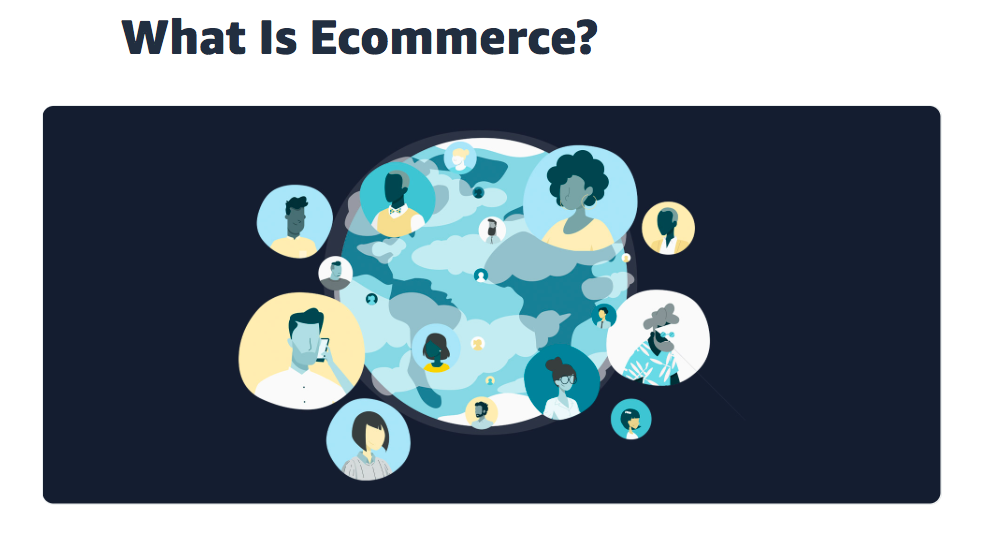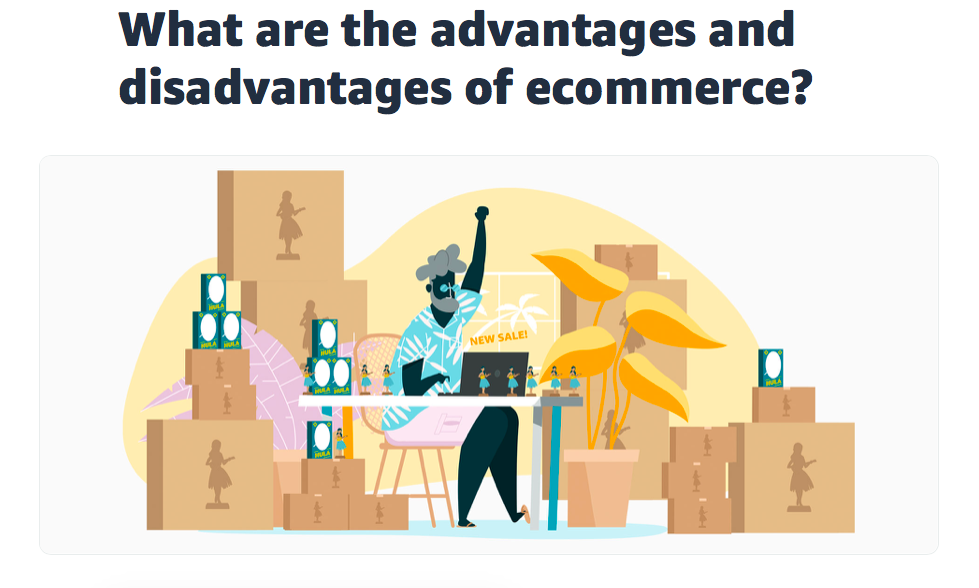E-commerce is the online trade of goods and services. Nearly 2.14 billion people worldwide shop online every year, and there are over 150 million Prime members who shop at Amazon worldwide.
Let’s discuss what e-commerce is, analyze its types and talk about the pros and cons of online trading.
E-commerce definition
E-commerce is one of the many ways people buy and retail stuff. Some companies only sell products online, but for many, ecommerce is a distribution channel that is part of a broader strategy that includes physical stores and other sources of income.

In any case, e-commerce allows startups, small businesses and large companies to sell their products on a large scale and reach customers around the world, according to Amazon.
E-commerce web-sites
An e-commerce website is your online digital showcase that facilitates a deal between buyer and seller.
Companies can either display their products on existing platforms like Amazon, or they can create their own commercial websites.
What are the types of e-commerce?

Here are a few common business models that are shaping the e-commerce world:
B2C – Companies sell products to individual consumers (end users). It is the most common model with many variations.
B2B – Businesses sell goods to other businesses. Often the buyer resells the product to the consumer.
C2B – Consumers sell goods to businesses. C2B businesses allow customers to sell products to other companies.
C2C – Consumers sell goods to other consumers. Companies create online marketplaces that bring consumers together.
B2G – Businesses sell goods to governments or government agencies.
C2G – Consumers sell goods to governments or government agencies.
G2B – Government or government agencies sell goods to businesses.
G2C – Governments or government agencies sell goods to consumers.
Where and how does e-commerce take place?
Online shopping is changing at lightning speed. People shop from their computers, phones, pads and other devices.
Mobile commerce
Online transactions via mobile devices are very popular.
“With portable devices in the hands of consumers worldwide, it’s no wonder m-commerce is expected to overtake non-mobile commerce in 2021,” Amazon says.
Corporate e-commerce
Corporate e-commerce is the buying and selling of products to large companies or organizations. If a large business sells many different types of products or has multiple lines of brands and moves to online sales, then it is engaging in corporate e-commerce.
Social media e-commerce
Social media can help one sell and promote e-commerce stores to a wider audience. With the right social media marketing, you can attract customers in an informal setting.
Social media may help you:
1. attract new customers
2. increase brand awareness
3. increase online sales
Pros and cons of e-commerce

E-commerce benefits
Selling online has a number of significant advantages:
– Rapid business development
In the 12 months ended May 31, 2020, US SMBs sold over 3.4 billion items in Amazon stores, up from 2.7 billion year on year. Overall, e-commerce sales are up over 30% in 2020. While the recent surge in online spending is largely due to the COVID-19 pandemic, experts predict this trend will continue beyond.
– Global marketing reach
Previously, a business’ reach was limited to the number of people who could physically enter through the front door of the store. Today, e-commerce allows you to attract customers all over the world. The rise in internet use and the rise of social media has made it easier for e-commerce business owners to reach a diverse new customer base.
– Ease of ordering products
With all the different types of e-commerce, customers can browse options and shop from anywhere with just a few clicks. Amazon makes it easy to sort and compare products by price or feature. Online payment innovations such as Amazon Pay are making the checkout process even easier.
– Lower operating costs
It costs less to build and maintain a website than a traditional store. You can start an online business without renting retail space, hiring a team of employees, or having a large warehouse.
All of these benefits help reduce overhead costs. You don’t have to pay rent or worry about building maintenance. Once connected to the internet, your store is open 24 hours a day and you don’t need to monitor it.
– Direct access to the consumer
Thanks to the internet, e-commerce brands can directly build relationships with their target audience. You don’t have to pay for a giant billboard or TV ad campaign to get your audience’s attention. You can tailor your brand and marketing to suit the wishes and needs of your customers, right down to special offers and individual product recommendations.
Well, now let’s move on to the e-commerce disadvantages.
Disadvantages of e-commerce
Despite its many advantages, e-commerce also has disadvantages:
– Limited personal communication
Face-to-face communication is really important for some businesses and transactions. Depending on your product, service, or sales style, it can be difficult to realize your full strength of your personality online.
While there is no magic solution, putting your brand story at the forefront can help you maintain your authenticity online. Alternatively, if you prefer to communicate with customers via email or phone, this disadvantage can be a huge plus!
– Technical difficulties
Technical problems beyond your control can negatively impact sales: Internet problems or hard drive failure can cost you time and money.
For every technical problem that may arise, there is a solution or preventive action that you can take. Be sure to back up your data regularly. Using a store like Amazon can help mitigate these risks with a robust technical infrastructure.
– Data security can be an issue
Customers are becoming increasingly wary of the storage and transmission of their information. It is worth building customer confidence by providing details of your privacy policy.
Amazon has been working to create secure shopping for decades, and companies that sell on Amazon benefit from longstanding customer trust. However, if you are creating a web-site, then you need to find a secure payment processing service so as not to put your customer data at risk.
– Global delivery and order fulfillment
When you’re just starting out with ecommerce, you can easily package and ship orders from your garage or spare room. But as your business grows, order fulfillment becomes more and more time consuming. A sudden rise in orders can make you struggle to fulfill orders. Using a service like Fulfillment by Amazon (FBA) can help reduce the burden on your business and meet customer needs.
Succeed in online trading
Building a brand isn’t as hard as developing it.
To be successful, focus primarily on your products and their quality. Also pay attention to your brand messages, your target audience, and your store’s user experience.
Consider a follow-up process to ensure that products are delivered on time for maximum customer satisfaction.
And, by the way, our Amaz.Markets team is always by your side and ready to help you in any question!
2



